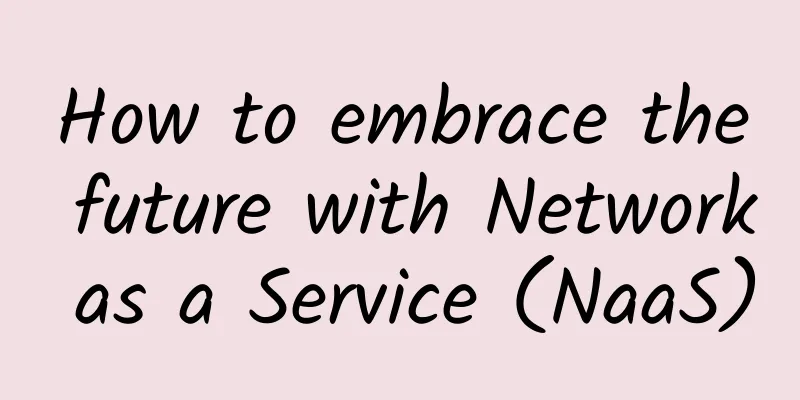Looking forward to the love and hate of IPv6 deployment in the new Internet era

|
With the explosive development of the Internet, traditional networks have shown various drawbacks, such as a shortage of IP addresses, cluttered network equipment, and unstable network security. With the planning and vision of the future Internet, new Internet definitions such as SDN and the Internet of Things have been vigorously applied and promoted. On the other hand, in terms of the essence of the Internet, the proposal and deployment process of IPv6 will directly affect the foundation of the future new Internet era.
A new Internet era embodied by the Internet of Things is coming "Love": Replacing IPv4 and taking a closer look at the qualitative improvement of IPv6 The protocol suite currently used by the global Internet is the TCP/IP protocol suite. IP is the network layer protocol in the TCP/IP protocol suite and is the core protocol of the TCP/IP protocol suite. The current version number of the IP protocol is 4 (abbreviated as IPv4), which has been used for more than 30 years. However, with the vigorous development of the Internet, as of December 2013, the number of Internet users in the world has reached 2.27 billion, and IPv4 can only provide about 4.29 billion IP locations. In order to solve the problem of serious consumption of the IPv4 address pool, in 1994, representatives from various IPng fields formally proposed the IPv6 development plan at the IETF meeting held in Toronto. IPv6 is the abbreviation of "Internet Protocol Version 6". It is the next-generation IP protocol designed by IETF to replace the current version of IP protocol IPv4.
IPv6 Compared with IPv4, IPv6 defines a new packet format for transmitting data. The address length of IPv6 is 128 bits and it can provide 2^128 IP addresses. Theoretically, more than 1,000 addresses can still be allocated per square meter of the entire earth, which almost completely solves the problem of the shortage of IPv4 address pool. In addition, for China, since IPv4 technology was born in the United States, the United States has most of the IPv4 address resources. The acquisition of IP addresses needs to be uniformly issued by the international organization NIC. my country's public network IP address resources cannot meet the allocation needs of Internet devices at all. Comparison of IPv6 and IPv4 address numbers In addition to the increase in the number of addresses, IPv6 also uses a smaller router table. The address allocation of IPv6 follows the principle of clustering from the beginning, which allows the router to use one record (Entry) in the routing table to represent a subnet, greatly reducing the length of the routing table in the router and increasing the speed at which the router forwards data packets, making it faster to connect and obtain content through IPv6 than IPv4. Compared with IPv4, IPv6 is not only about a larger address pool and faster speed, but also brings about an evolution in security. Traditional network security mechanisms are only built at the application level, such as E-mail encryption, SNMPv2 network management security, access security (HTTP and SSL), etc. There is no way to ensure the security of the Internet from the IP layer. IPv6 achieves IP-level security, and users can encrypt data at the network layer and verify IP packets, ensuring the integrity and confidentiality of packets. In addition to security, IPv6 can also provide us with an optimized configuration management solution. When connected to an IPv6 network, an IPv6 host can use the neighbor discovery protocol to automatically configure itself. When connected to the network for the first time, the host will send a link-local router request to obtain configuration parameters, and the router will respond with a router announcement message containing Internet layer configuration parameters. This is an improvement and extension of the DHCP protocol, and in scenarios where IPv6 stateless underlying automatic configuration is not suitable, the network can use DHCPv6 stateful configuration or manually configure using static settings. IPv6 Networking Applications In contrast, IPv6 will be able to bring us faster transmission rates, larger address pools, and more optimized configuration and management solutions than IPv4, and IPv6 also supports expansion, allowing the protocol to be expanded even in the face of new technology applications. In short, IPv6 has the characteristics to meet our various requirements for the future Internet, but it still faces certain difficulties in the road to full deployment and implementation of IPv6. "Hate": IPv6 deployment lacks motivation Generally speaking, the problems faced by IPv6 deployment are that the demand is not strong enough and the advantages cannot bring obvious benefits. The transition plan for IPv6 mainly uses a dual-stack conversion mechanism. Dual stack regards IPv6 as an extension of IPv4 and implements the network stack in a shared code manner. It can support both IPv4 and IPv6 at the same time. However, for operators and website builders, since they can support both IPv4 and IPv6 at the same time, there is no need to rush to convert to IPv6. Computers generally support both IPv4 and IPv6 Deploying IPv6 costs a lot of money. Due to compatibility issues with equipment, upgrading to IPv6 means the abandonment and replacement of a large number of network devices. Even after spending money to upgrade the equipment to support IPv6, the benefits gained from operations will not be significantly greater than in the past. If all websites are not built to support IPv6, they will not be able to use the IPv6 network. Therefore, most operators and website builders are not actively converting to a full IPv6 network. For domestic users, the emergence of NAT address translation technology has effectively solved the problem of insufficient IP addresses. Most users do not actually care whether they are connected to a private IP or a public IP. Most people do not even know the concepts of private IP and public IP. Most people do not have the awareness of protecting network information security. As long as the existing stability and speed can be guaranteed, there is no reason to change equipment and use IPv6. Overseas, large ISPs (Internet Service Providers) such as Google and Facebook have already migrated a large number of applications to IPv6 networks. In fact, some ISPs in my country have also migrated some applications, but they do not provide deep-level services. Some domestic ISPs are not in the international competitive environment, so whether they can build and take the lead in using IPv6 networks is not important. However, the Ministry of Industry and Information Technology has recently issued the "Notice on the Implementation of the Action Plan for Promoting Large-Scale Deployment of Internet Protocol Version 6 (IPv6)", which mentions "backbone network IPv6 interconnection. By the end of 2018, the IPv6 transformation of Internet backbone direct connection points in Beijing, Shanghai, Guangzhou, Zhengzhou and Chengdu will be completed, and the IPv6 network interconnection bandwidth will be opened to no less than 1Tbps. By the end of 2020, the IPv6 transformation of all Internet backbone direct connection points will be completed, and the IPv6 network interconnection bandwidth will be opened to no less than 5Tbps." From this, we can feel that the strong support of the country is driving the accelerated development of Internet innovation. Screenshot of the Ministry of Industry and Information Technology's "Action Plan for Promoting Large-Scale Deployment of Internet Protocol Version 6 (IPv6)" Compared with IPv4, IPv6 represents a faster, more secure and more stable Internet network. In the era of vigorously developing and applying the Internet of Things, IPv6 can provide a high-quality network foundation for the realization of the Internet of Things. Although the promotion and deployment of IPv6 face many problems, with the strong support of the country, these problems may be solved, and the faster and more secure IPv6 will be able to come to us as soon as possible with the new Internet era. |
>>: What will 5G technology bring to the three major operators?
Recommend
What Data Center Operators Need to Know About Expanding to 400GE Networks
Today, many data center operators need to expand ...
AT&T and Microsoft team up for private 5G edge deployment
To further accelerate its goal of deploying priva...
5G technology can now read human emotions in public areas
[[403225]] The birth of a new and influential 5G ...
In the 5G era, virtual operators “disappear”
[[269893]] "In the 4G era, the three major t...
Gcore (gcorelabs) Santa Clara VPS simple test
A few days ago, we posted simple test information...
VirMach: $1.15/month KVM-512MB/15GB/1TB/multiple data centers available
VirMach released several special packages on Blac...
A must-have for 5G engineers! A complete list of 5G protocols
The three major operators have already commercial...
Liu Liehong: To get rich, we must not only build roads, but also build information highways
[[398027]] 2021-05-08 09:07Focus, broadcast on th...
Animation: How does a browser work?
For most of the front-end developers interviewed,...
Analysis of the current status of cloud computing industry development, challenges faced by operators in their layout
Domestic operators are making great efforts to la...
Huawei releases 5GtoB Suite solution to inject new impetus into the development of network services in the operator industry
[Shanghai, China, November 13, 2020] During the 2...
Highlights | Speech content of the 39th GTI seminar (1/2)
On February 24-25, the 39th GTI seminar was held ...
Ruijie Networks' scenario-based wireless technology helps Suning's new shopping model of "Internet + Retail"
As a leading enterprise in China's private en...
PacificRack VPS, 5-253 IPs per year starting from $50
PacificRack is a site under QN Data Center, mainl...
Hosteons: AMD Ryzen CPU + NVMe high-performance VPS is available starting at $24 per year
Hosteons is a foreign VPS hosting company founded...









